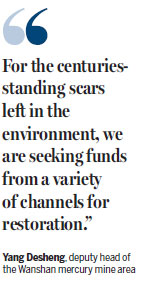
Mountainous Guizhou province in Southwest China is making full use of international environmental research cooperation to restore its ecosystem.
The province has long been known for its rich reserves of mercury, its long history in extracting the heavy metal, and the resulting pollution.
The region has been designated as one of two pilot provinces in the country for a mercury pollution treatment project supported by the United Nations Environment Program and the Global Environmental Facility, an independent international financial entity focusing on helping to reduce global environmental threats.
The Foreign Economic Cooperation Office at the Ministry of Environmental Protection, also known as the Environmental Convention Implementation Technical Center, was responsible for the project's implementation, which was completed at the end of last year.
In recent years, the center conducted research into mercury emissions in Guizhou and Hunan provinces, as well as from coal-fueled power stations and polyvinyl chloride plastic material production facilities nationwide.

Tongren, in the northeast of Guizhou, was one of China's earliest regions to adopt mercury mining and usage, with its related history dating back to the Tang Dynasty (618-907), according to local records.
The city is home to a number of large mercury mining areas, including Wanshan, which ranked top in Asia and No 3 in the world for its mercury reserves.
The Wanshan mining area supplied a total of roughly 20,000 metric tons of metallic mercury from 1950 to 1998.
Especially during the 1959-64 period, annual output surpassed 1,000 tons in the mining area.
Although Wanshan's mineral reserves have begun to dry up, Guizhou has maintained its status as a key hub of mercury production and distribution in the country.
A lack of environmental awareness in the industry in the early days has left the province exposed to heavy mercury pollution.
The Environmental Convention Implementation Technical Center found that mercury production facilities and coal-fired power plants are major emission sources.
Other involved businesses include coal-fueled industrial furnaces, nonferrous metal smelters, cement and battery production facilities, and lead and zinc metallurgy.
The center conducted thorough research into emission sources, channels and output. The data laid a foundation for pollution control and treatment.
The Tongren government signed a strategic agreement on mercury pollution treatment with the center and other institutes at the ministry and the Chinese Academy of Sciences in late 2016.
The partnership is of far-reaching significance, as Tongren has been named a forerunner in a national plan for soil pollution treatment released by the State Council, China's Cabinet, said Chen Liang, head of the center.
Local authorities have already begun to clean up mercury-contaminated sites in the area.
During the 12th Five-Year Plan period (2011-15), they poured more than 300 million yuan ($43.74 million) into clearing out six mine tailings, treating waste gas and water from more than 10 local companies and restoring more than 67 hectares of farmlands.
Wanshan has received annual funding of nearly 100 million yuan in government aid for heavy pollution treatment for three consecutive years starting in 2015.
Yang Desheng, deputy head of the area, told Xinhua News Agency, "For the centuries-old scars left in the environment, we are seeking funds from a variety of channels for restoration."
zhuanti@chinadaily.com.cn
|
Terraced fields in the Wanshan area of Guizhou province. Famed as China's mercury capital for its rich reserves, the area was selected as a pilot test zone in mercury pollution remediation. Photos Provided To China Daily. |
|
A mercury mine in Wanshan, which has a long history of mining the heavy metal. Local officials have introduced measures to reduce the impact of pollution. |
(China Daily 05/31/2017 page15)